ORDER
Phoenicopteriformes
FAMILY
Phoenicopteridae
GENUS & SPECIES
KEY FEATURES
• Inhabits tropical salt pans, lagoons and alkaline lakes
• Skin on feet and legs can withstand burning effects of caustic soda, found in alkaline lakes
• Breeds in huge colonies — over a million individuals
• Uses extraordinary specialized bill to filter food in shallow water
WHERE IN THE WORLD?
Mainly on lagoons and large inland lakes in Africa, the Middle East, India and Sri Lanka, extending into subtropical southern Europe; deep pink variety in Caribbean and Galapagos Islands
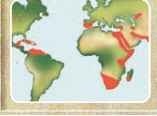
Lifecycle
The greater flamingo steps elegantly through shallow lakes and lagoons, sweeping its highly specialized bill from side to side to filter tiny food items from the water.
Habitat
The greater flamingo inhabits lagoons, salt pans and large, shallow lakes, from sea level to altitudes of over 9,900′. Conditions across its range are very harsh with high temperatures. The salt waters can be very alkaline and contain high levels of caustic soda. However, the heat and salt stimulate the growth of plankton, algae and aquatic invertebrates. Few animals could exploit such hostile waters but the flamingo is equipped to thrive.
Breeding
Throughout its tropical and subtropical range, the flamingo breeds when food supplies are good and the water level is high enough to soften the shoreline mud (from which it builds its nest). The nest’s platform structure protects the egg from searing heat by exposing it to breezes and drawing up moisture to cool the nest as it evaporates. The height of the nest helps the leggy flamingo when incubating, as it can straddle the nest. The nests are built in large colonies on mudflats, salt pans and islands. Pairs defend the nest with threat postures, but fights among neighbors are rare.
Several days before the chick hatches, it cheeps and the parents respond, learning to recognize each other’s calls.Then, after the chick hatches, the parents, returning from a feeding trip, are able to find it quickly among the hundreds of other identical nests in the colony.
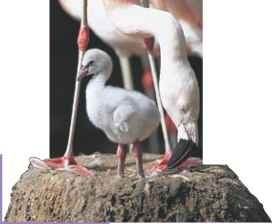
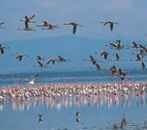
In the fink Lake Nakuru, in Kenya, supports huge flocks of greater flamingos.
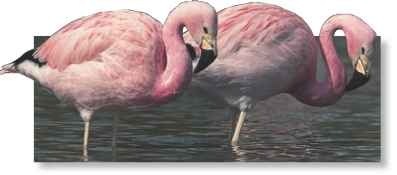
Many chicks die from exhaustion and starvation when their legs become encrusted with salt from around the nest.
The silhouette of a flamingo was used by the ancient Egyptians to symbolize the color red.
The flamingo’s pink feathers are a vital stimulus for reproduction. Poor diet can cause a bird to lose its color and the opportunity to breed.
flamingo dancing

Inciting…
When a few flamingos begin a breeding display, other adults join in. Eventually a forest of flamingos may join the performance.
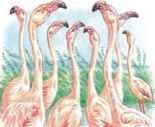
Posing…
Pointing their bills to the sky, males strive to stretch higher than rivals, then rhythmically turn their heads from side to side.
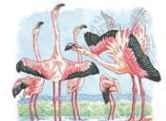
Displaying…
To further impress females, males spread and flash their wings, exposing the crimson underwing, edged by black flight feathers.
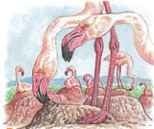
Nest building
Once paired, the flamingo builds a mud nest with a shallow bowl on top. The single chalky-white egg is incubated by both parents.
BEHAVIOR
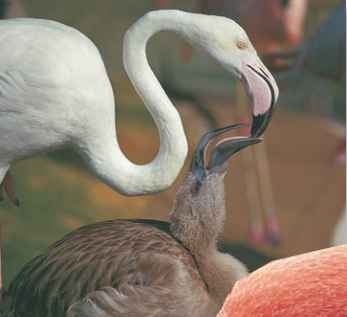
A Flamingo milk Adults produce milky fluid in their digestive tracts, which they feed to the chick.
Often found in large groups, the flamingo gathers on shorelines of tropical lagoons and salt lakes where it can wade in the shallows on its long, stiltlike legs. It can live in temperatures that climb daily to more than I04°F and drink water that is twice as salty as the sea. Highly sociable, the flamingo’s communal nature extends to caring for young. When a chick fledges, it joins a nursery supervised by a few adults, allowing the other parent birds to feed.
CONSERVATION
Apart from the Caribbean where populations are hunted for food or sport, the flamingo is under little threat, partly because its harsh, remote habitat isn’t exploited by humans.
FOOD & FEEDING
The greater flamingo has a specialized system of feeding that is unique among birds. The bill is held upside down, facing backwards, and horizontal to the water surface. The flamingo walks slowly forward. swinging the bill from side to side. The tongue works like a piston, pumping water 5-6 times a second through the partly opened mandibles. Food items — algae, tiny crustaceans, mollusks and aquatic insects — are filtered by a special comblike structure lining the bill, then scooped off by the tongue to be swallowed.
In shallows, the flamingo dips its bill upside down just under the surface. In deeper water, it uses its long neck to reach bottom mud. On alkaline lakes, however, the flamingo can only feed on the surface, because its eyes would be burned by the powerful chemicals.
Foodbill
The flamingo may eat up to 9.5 oz. of tiny filtered food particles each day.

PROFILE
Greater Flamingo
The greater flamingo has legs that resist burning chemicals in some feeding waters and a special bill to trap tiny organisms.
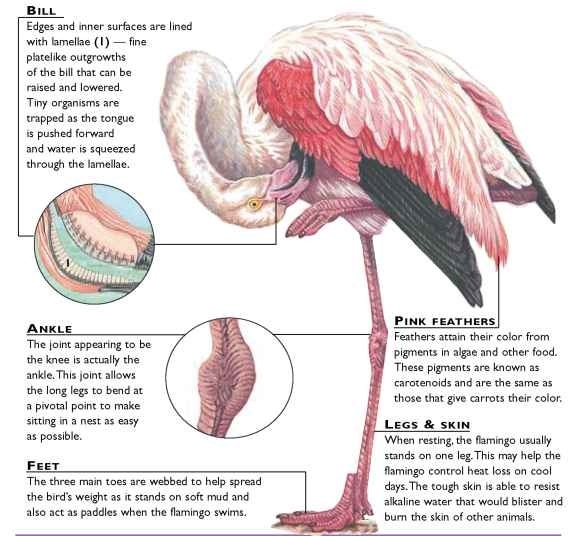
Creature comparisons
The roseate spoonbill (Ajaia ajaja), another pink-plumed bird found alongside the flamingo in the Caribbean has a similar-shaped bill. Holding its mandibles slightly open and bill vertical, the spoonbill feeds by sweeping from side to side through shallow water. The spoon-shaped bill is equipped with numerous vibration-sensitive receptors. When aquatic organisms touch the receptors the bill rapidly snaps shut. Both species rely on their bill structure to feed without actually seeing their food.

| VITAL | |
| STATISTICS | |
| Weight | 4.6-9 lbs. |
| Length | 4-4.8′ |
| WlNGSPAN | 4.6-5.4′ |
| Sexual Maturity | 5-6 years |
| Breeding 1 Season | Variable, according to locality |
| Number of Eggs Incubation Period |
1, rarely 2 ‘” 27-31 days |
| Fledging Period | 65-90 days |
| Breeding Interval | 1 year |
| Typical Diet Lifespan |
Mainly aquatic invertebrates and algae Up to 33 years in the wild; 45 in captivity |
RELATED SPECIES
• The Puna and Andean flamingo, (Phoenicoparrus jamesi and P. andinus), have restricted ranges in South America, living at high altitudes on the salt lakes of Peru and Bolivia, Argentina and Chile. Both have yellow, not pink, on their bills, and no hindtoe. Known for huge gatherings in East Africa, the lesser flamingo (Phoeniconaias minor) also occurs in northwest India and Pakistan.

